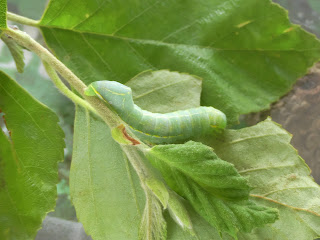Copper Underwing Caterpillar
I believe this caterpillar to be a Copper Underwing [1]. At least the coloring and the dorsal hump (near the left end of the caterpillar) seem consistent with the Copper Underwing. These caterpillars are not what you'd consider picky eaters; my Caterpillars of Eastern North America describes their diet thusly:
Many wooded plants including apple, basswood, blueberry, cherry chestnut, current, grape, greenbrier, hawthorn, hickory, lilac, maple, oak, poplar, raspberry, rhododendron, viburnum, Virginia creeper, and walnut.
Wikipedia adds:
Ash, privet, honeysuckle, rose, and service trees.That's a pretty wide range of trees and shrubs. One of the challenges of finding them is that they could be almost anywhere; the other challenges are:
- Their green coloring blends in pretty darned well with the average leaf.
- They have a habit of feeding underneath leaves, so they're probably not visible when looking down at their location.
- They have a tendency to move from leaf-to-leaf; if you (or a predator) are looking for damaged leaves, you're more likely to find out where the caterpillar was than where it is.
The adults (moths) have hindwings with a coppery-orange look to them, though this isn't the best field mark since usually their forewings cover their hindwings, obstructing your ability to detect copper on the wings. While this is inconvenient for us, the non-coppery forewings do provide better camouflage than their more colorful hindwings.
The species part of their name, pyramidea, is probably due to the pyramid-like dorsal hump that helps identify these caterpillars.
 |
| May 13, 2023 at Duke Farms Photo 282422975, (c) jpviolette, some rights reserved (CC BY-NC) |
[1] I have a vague recollection that this fella showed up at one of the spring Outdoor Education sessions I was doing much of last year.



Comments
Post a Comment